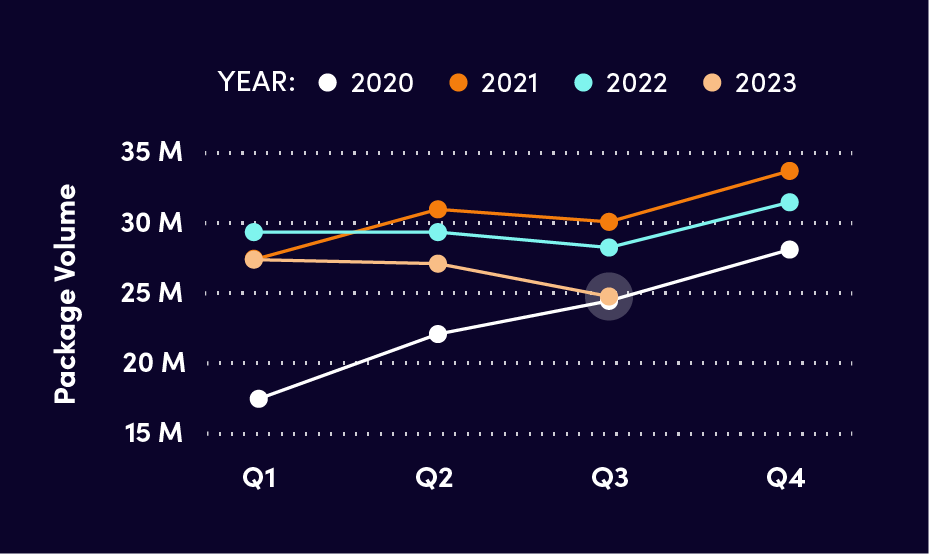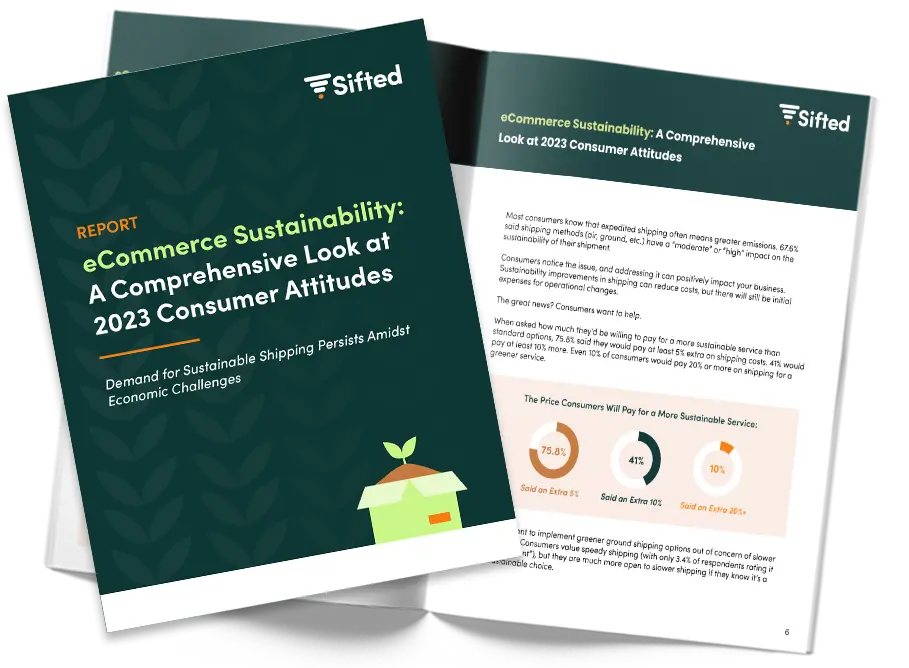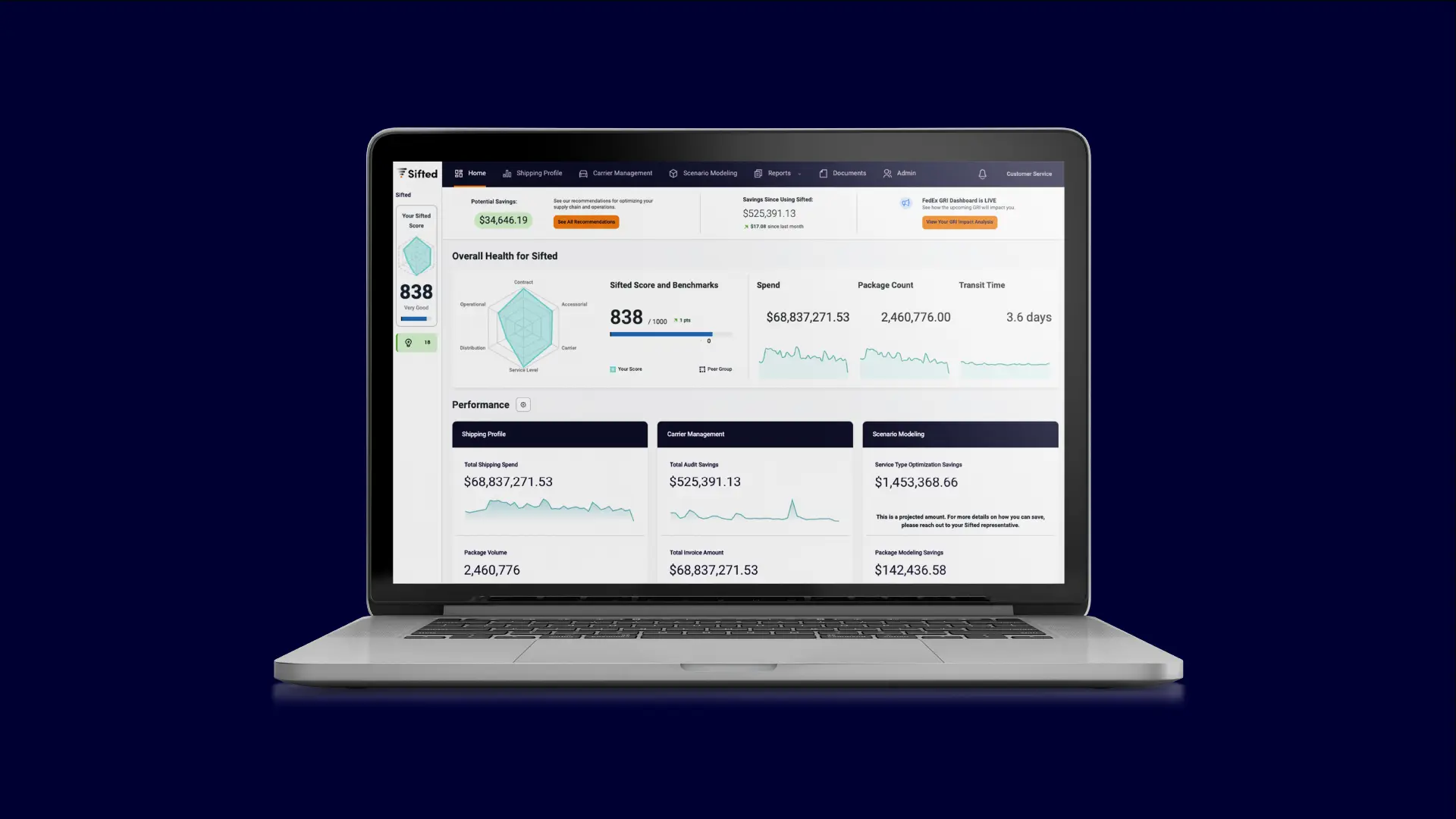Over the last few years, soaring shipping costs, unpredictable rate hikes, and a challenging logistical landscape have burdened businesses. It’s been a struggle to maintain profitability amid escalating costs, especially when the cost to ship has increased by as much as 20% since 2021.
Things are finally looking up.
In 2024, businesses will have an opportunity to reclaim control over their bottom line and their shipping operations. But it requires a proactive and strategic approach to make the most of this new opportunity.
In this blog, we’ll highlight five 2024 shipping trends that are driving down shipping costs. We’ll also provide actionable tips to help you take advantage of these trends so your business can boost its bottom line and run a more sustainable business in 2024 and beyond.
Trend #1: It’s a shipper’s market – take advantage of it
After weathering a COVID shipping frenzy that drove carrier capacity to the breaking point and skyrocketed shipping costs, the market is showing signs of stabilization. Shipping volumes have normalized as more people have returned to stores. The major carriers, FedEx and UPS, have gone from not enough capacity to too much open capacity. Express services have seen the greatest impact, which is one reason UPS offered early retirement to almost 200 veteran pilots.
As a result, both carriers are looking to capture more volume and are making pricing concessions to do so. In its own 2024 air freight outlook, UPS indicated that “rates will likely remain low for the first nine months of 2024, with a potential for growth and a return to true peak shipping season in Q4.”
On top of it being a shipper’s market, shippers have also gotten smarter. The past few years have pushed businesses to think differently about how they ship – and many are using intelligent tools to help them optimize their shipping operations, develop partnerships with additional fulfillment companies, and expand their distribution footprint to utilize ground services more and express services less.
Action: Take a comprehensive look at your shipping data
Shippers have the upper hand and need to take immediate action to reduce costs. Start by looking at your shipping data to determine where costs are highest so you know where you should focus your efforts.
Trend 2: The carrier marketplace is more competitive – making it the perfect time to diversify
Back in 2021, when shipping volume exploded and the major carriers put volume caps in place, many businesses found that relying on a single carrier held significant risk as they were left scrambling for alternative options to ship their products.
In addition, larger carriers have become selective with the types of packages they want to ship and the locations they want to service. With significant year-over-year increases in additional handling fees and extended delivery surcharges, FedEx and UPS have sent a clear signal that they are focused on deliveries that create efficiency and higher yields.
The good news is that the carrier marketplace has become more competitive and diverse these last few years. Amazon and OnTrac continue to grow their network, and other regional carriers offer an opportunity to diversify. For instance, once OnTrac completes its network expansion to Texas, they will be able to reach 80% of the U.S. population. Diversifying with regional carriers for deliveries close to your warehouse or distribution centers can significantly lower shipping fees and speed up transit times.
New services that provide options for how and where packages are delivered are also emerging. Walmart, for instance, is using 4,000 of its stores as delivery hubs to deliver packages for both Walmart and third-party retailers through Walmart GoLocal. It has added parcel stations to those hubs, which act as mini-post offices. We anticipate seeing a lot more retailers begin to offer similar alternate pick-up locations or services.
Action: Create a carrier diversification strategy
A good carrier diversification strategy should consider carrier swim lanes, such as using a major carrier for your national shipping needs, while using local carriers in locations that are close to your warehouse or fulfillment centers. This will help to lower costs and reduce risk in the long run. Your diversification strategy should also look at how you can diversify package pick-up on the consumer side. Incentivizing customers, especially in extended delivery areas, to utilize alternative pick-up locations can also help lower costs.
Carrier Diversification Tips + Tools Demo
Trend 3: Carriers want more volume – making it easier to renegotiate contracts
The post-Covid volume normalization is here to stay (for now). Our data continues to support this (see graph below). As a result, the Wall Street Journal reported that both UPS and FedEx are offering discounts and cost relief to customers.

This shift in pricing strategy on the carrier side, after years of steep increases, makes 2024 the year to renegotiate and revise your contracts. While many businesses negotiate their carrier contract every two to three years, those who choose to wait and don’t renegotiate this year will likely miss out on substantial savings.
Action: Determine your top five accessorial charges
Evaluate what accessorial charges are costing you the most, such as additional handling, extended-area delivery, or DIM weight. When you renegotiate your contract, ask for discounts in those areas. It will have the biggest impact on lowering your costs.
Trend 4: Sustainable shipping remains a hot button item – now is the time to invest
Consumers want brands to reduce their impact on the environment and adopt greener transportation practices. In a recent survey, 57% said sustainable packaging and shipping was important when purchasing online—and 80% said they were willing to wait longer to receive packages if shipping was more sustainable.

Report: 2023 eCommerce Sustainability
2024 is a good year to experiment with more sustainable shipping practices. From reducing box sizes to lowering your carbon footprint, there are many ways to become a more sustainable shipper. Some of the costs to implement sustainable shipping practices can be offset by getting lower rates with carriers (see trend 3). Moreover, with higher fuel prices and last-mile delivery expectations surging, strategic sustainable efforts will even have a positive impact on your profits and consumer perceptions of your business.
Action: Calculate your shipping carbon (CO2) emissions
Before you can reduce your impact – you need to know what it is. CO2 emissions from ground/air travel can be calculated by multiplying the distance your shipment has traveled (D) times the weight of your shipment (W) times your transportation mode’s specific emissions factor (EF). To make this easier to calculate, you can use our CO2 calculator.
Trend 5: AI is hitting the shipping industry – explore new technologies to gain efficiency
Advancements in artificial intelligence exploded in 2023, and there are now new technologies on the market that can help improve shipping operations. This includes using AI for predictive use cases like analyzing future shipping costs based on historical shipping data, as well as identifying opportunities to reduce costs by making changes to your shipping operations.
AI technologies can help with what box size to use and how to package your products for minimal shipping fees – and it can be done in real time. Technologies have also emerged to help ensure you’re shipping from the right location or to help minimize the cost of returns.
Action: Explore new technologies
Take time this year to explore new technologies on the market. This may include AI-powered technologies that enable route optimization, predictive analytics, warehouse automation, or more personalized customer experiences. Evaluate whether these investments will create operational efficiencies that can help you lower your shipping costs, improve sustainability, or elevate your overall customer experience.
Centralize and analyze your shipping data in 2024
There is a real opportunity this year to increase efficiency and sustainability while lowering shipping costs. But to take full advantage of the opportunities 2024 presents, you’ll need insights from your shipping data to know what actions will have the biggest impact on your bottom line and the overall efficiency of your shipping.
Having your shipping data in a logistics intelligence platform like Sifted gives you visibility into carrier rates, accessorial fees, and performance. This data is necessary to negotiate your contract with your carrier to get the best overall rates for your business. Your shipping data can also help you identify hidden costs in your distribution and fulfillment strategy—whether that’s bad addresses, inefficient packaging, or unoptimized service levels.
Learn how Sifted can help you in 2024 and beyond by getting your free Sifted Score Based on 20+ factors across six key areas (contract, carrier, distribution, accessorial, service level, and operational). You’ll get insights into where you need to pivot to improve your bottom line in 2024.











